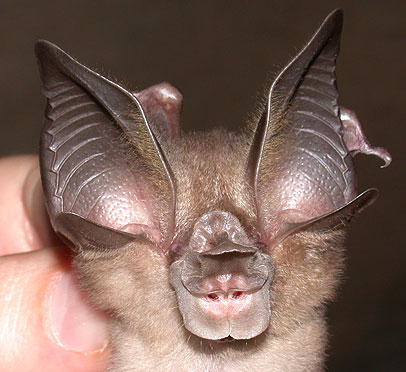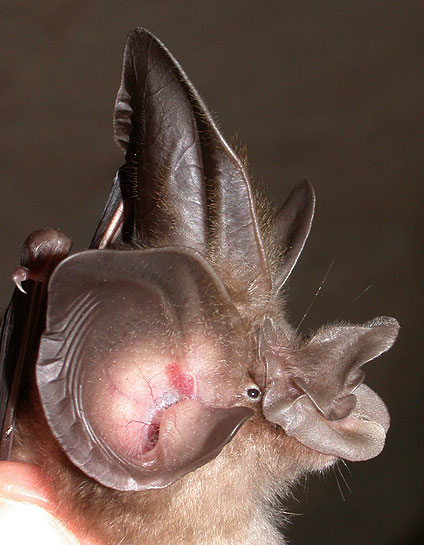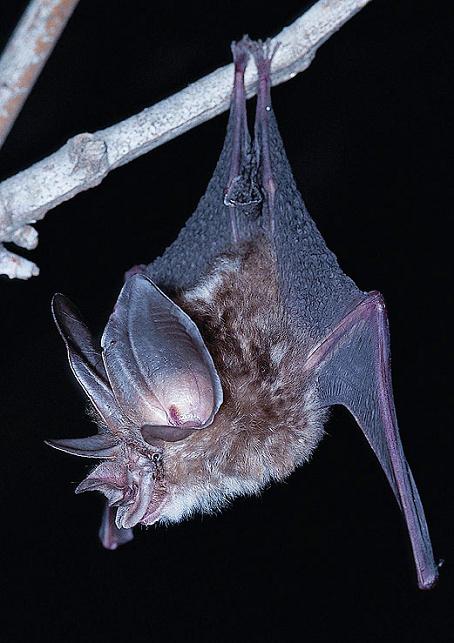Rhinolophus rex
King Horseshoe Bat
Morphological description Life history Distribution Habitat Roost sites and roosting patterns Emergence and flight pattern Foraging behaviour Echolocation calls Status and protection



Morphological Description
· Dorsal fur is darker brown. Ventral fur is greyer.
· The body size is large for a horseshoe bat. Forearm length 56.5-63.0mm (Csorba et al., 2003). We recorded forearm lengths of 54.9 - 56.1 mm in Guangxi (n = 3). A bat captured in Yunnan had forearm length of 57.5 mm.
· The ears are enormous: 29.1-35 mm in length (Csorba et al., 2003).
· The horseshoe is quite wide, without a secondary leaflet. The sella is very big, long, and tongue shaped. The connecting process is low, with a convex outline. (Csorba et al ., 2003)
· Body mass 10.8-12 g (n = 4).
R. rex is distinguished from R. paradoxolophus purely on the basis of small differences in body size. R. paradoxolophus has a forearm length of 50.5-57 mm, R. rex 56.5-63 mm (Csorba et al. 2003). The bats we captured in Guangxi had forearm lengths that would classify them asR. paradoxolophus, while our Yunnan bat had a forearm length that fits the measurements for R. rex. Nevertheless, the bats called with similar frequencies of most energy in their echolocation calls. Francis (in Eger & Fenton 2003) recorded R. paradoxolophus at 22-25 kHz in Lao PDR, and hence it appears that the call frequencies used by R. paradoxolophus and R. rex are identical. Fenton recorded R. paradoxolophus at 43 kHz in China (in Eger & Fenton 2003), but presumably measured the third harmonic of a signal with a fundamental at 13 kHz. We consider that the small differences in forearm length are inadequate descriptors of taxonomic distinctiveness betweenR. paradoxolophus and R. rex, and given that their echolocation calls are identical that they are probably the same taxon. Because R. rex (1923) was named before R. paradoxolophus (1951) we suggest that the taxa are synonymised under the name R. rex and considered as one species. An account of the biology of R. paradoxolophus is given by Eger & Fenton (2003).
Life history
· Little known. Litter size of R. paradoxolophus is one (Eger & Fenton 2003).
Distribution
R. rex is restricted to southern China (Csorba et al. 2003). The Chinese distribution is shown by the dots on the map below (as given by Zhang et al . 1997). R. paradoxolophus has a wider distribution and is found in vietnam, Lao PDR and Thailand.

Habitat
· Little known.
Roost sites and roosting behaviour
· Generally roosts in caves.
· This species often shares cave roosts with other bat species. Usually found singly or in small numbers.
Emergence and flight pattern
· Most rhinolophid bats have wing shapes that make them adept at foraging in cluttered environments.
Foraging behaviour
· R. paradoxolophus was netted in dry pine forests in Thailand, and is thought to be strongly associated with limestone formations (Eger & Fenton 2003).
Echolocation calls
The echolocation call is a long constant frequency signal, with a brief frequency-modulated start and tail. Frequencies with most energy recorded from hand-held bats ranged between 25.6-26.4 kHz (n = 3; Guangxi) and 24.6 kHz (n = 1 in Yunnan). Most energy is in the second harmonic of the call. Calls are audible when bats fly close by, probably because listeners can here the first harmonic of the call at about 13 kHz.
Status and protection
· There is no estimation of population size in China.
· Pearson's horseshoe bats are Vulnerable (VU), assessed by the Red List of Threatened Species (IUCN, 2006): the species is geographically widespread, although little studied. The species is not listed in the Law of the People's Republic of China on the Protection of Wildlife in 1989.
· Caves should be protected as important habitats.